
Brief 18 is also available as an Adobe PDF file.
The West Virginia Medicaid program provides health care coverage to low-income adults and children. Medicaid recipients are of particular interest to public health programs because many health conditions, including asthma, are inversely associated with socioeconomic indicators such as income. That is, individuals with low levels of income are more likely to have chronic health conditions. In fact, the prevalence of asthma is more than 2.5 times higher among West Virginia adults with an annual income less than $25,000 than among those with an income of $50,000 or more (14.1% vs. 5.4%) (Source: 2003-2005 Behavioral Risk Factor Survey).
West Virginia public health programs are working to reduce socioeconomic disparities related to chronic disease and access to health care. The first step is to identify and understand the burden of disease among West Virginians of low socioeconomic status. Therefore, the West Virginia Asthma Education and Prevention Program funded a project headed by Michael Smith, Ph.D., R.Ph., at the West Virginia University School of Pharmacy to analyze 2003 West Virginia Medicaid claims data to determine: 1) the prevalence of asthma in the West Virginia Medicaid population, 2) asthma-related medical services and prescription utilization among Medicaid recipients, and 3) the amount reimbursed for asthma-related services and prescriptions by West Virginia Medicaid. It is important to note that the methodology used in this report may overestimate the prevalence of asthma and asthma-related medical service visits and reimbursements. See the Appendix for a discussion of the study methodology and for detailed data tables.
Table 1.
Summary of Utilization of Asthma-related Health Care by West Virginia Medicaid Recipients, 2003
| TOTAL ASTHMA UTILIZATIONa | ||||
|---|---|---|---|---|
| Type of utilization | Number of recipients with asthma |
Prevalence rate per 1,000 recipients |
Total amount reimbursedd |
Average reimbursed per recipient |
| Total asthma utilization | 51,041 | 139 | $30,546,910 | $598 |
| MEDICAL VISIT UTILIZATIONb | ||||
| Type of utilization | Number of visits | Rate of visits per 10,000 recipients |
Total amount reimbursed |
Average reimbursed per visit |
| Office/Clinic visits | 39,185 | 1068 | $3,837,147 | $98 |
| Emergency Room visits | 6,517 | 178 | $1,270,555 | $195 |
| Hospitalizations | 2,189 | 60 | $8,829,409 | $4,034 |
| PRESCRIPTION UTILIZATIONc | ||||
| Type of utilization | Number of claims for asthma-related drugs |
Average number of claims per recipient |
Total amount reimbursed |
Average reimbursed per recipient |
| Prescriptions | 137,420 | 8.1 | $7,021,517 | $414 |
| ASTHMA PREVALENCE & TOTAL REIMBURSEMENTS |
|---|
In 2003, approximately 14% of West Virginia Medicaid recipients had asthma. This equals more than 51,000 of the nearly 367,000 Medicaid recipients. Recipients were identified as having asthma if they had at least one medical service claim (office/clinic, emergency room, or hospital) with a primary or secondary diagnosis of asthma (ICD-9 CM codes 493.00-493.99), or at least two prescription claims for asthma-related drugs, of which at least one was for a drug other than an oral steroid1. The prevalence of asthma was highest among recipients that were aged 21 to 64, female, and white (see Figure 1). In 2003, Medicaid reimbursed more than $30.5 million for asthma-related medical service and prescription claims (see Figure 2). This is an average of approximately $600 per recipient with asthma.
1. The definition used to identify recipients with asthma is based on modified criteria of the National Committee for Quality Assurance (NCQA). Oral steroids are used to treat many conditions other than asthma. Therefore, if a recipient had a claim for an oral steroid, he/she must also have had an asthma-related prescription claim for a medication in another pharmacotherapy class to be classified as having asthma. See Appendix for a more detailed discussion of the study methodology.
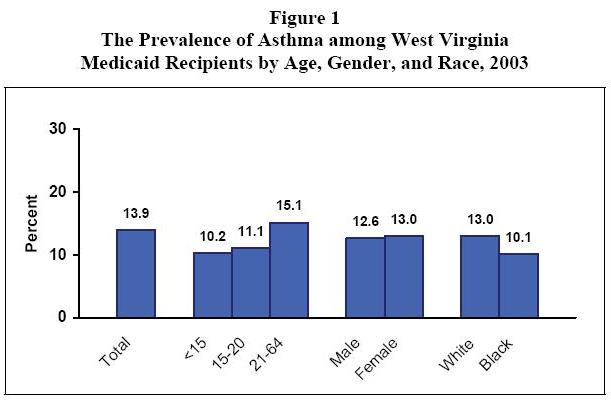
See Appendix for the methodology used to identify enrollees with asthma.
See Appendix Table A1 for more detail.
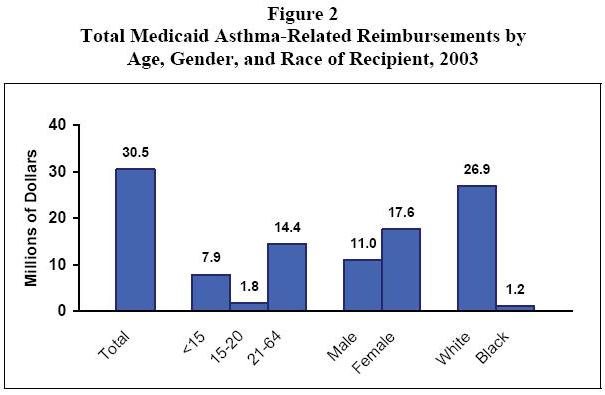
See Appendix Table A1 for more detail.
| MEDICAL SERVICES USE & COSTS |
|---|
Asthma-related medical services were defined as office/clinic visits, emergency room (ER) visits, and hospitalizations with a primary or secondary diagnosis of asthma2. In 2003, there were 39,185 office/clinic visits, 6,517 ER visits, and 2,189 hospitalizations for asthma-related illnesses among West Virginia Medicaid recipients. Adults aged 21 to 64 and females had higher rates of all types of medical services visits compared with other age and gender groups (see Figure 3, Figure 4, and Figure 5). The rate of office/clinic visits was higher among whites than blacks, while blacks had higher rates of ER visits and hospitalizations.
Medicaid reimbursements for asthma-related medical services totaled nearly $14 million. Reimbursements for hospitalizations accounted for nearly two-thirds (63.4%) of this total. Medicaid reimbursed an average of $98 per office/clinic visit, $195 per ER visit, and $4,034 per hospitalization (see Table 2).
2. If a recipient had an ER and hospital claim on the same date of service, then it was assumed that a recipient visited the ER and then was subsequently admitted to the hospital. In this circumstance, the event was classified only as a hospitalization to avoid double counting. See Appendix for a more detailed discussion of the study methodology.
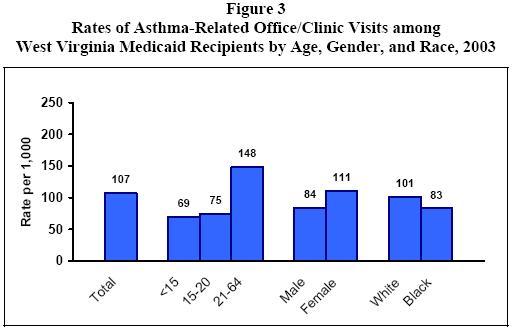
Note: Based on claims with a primary or secondary diagnosis of asthma.
See Appendix Table A2 for more detail.
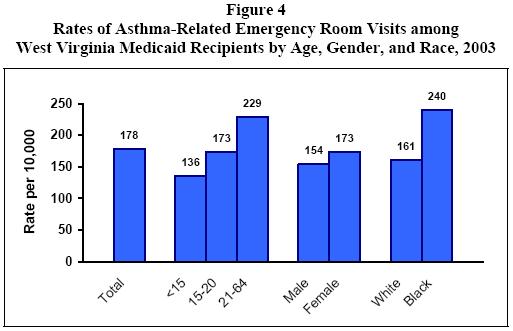
Note: Based on claims with a primary or secondary diagnosis of asthma.
See Appendix Table A3 for more detail.
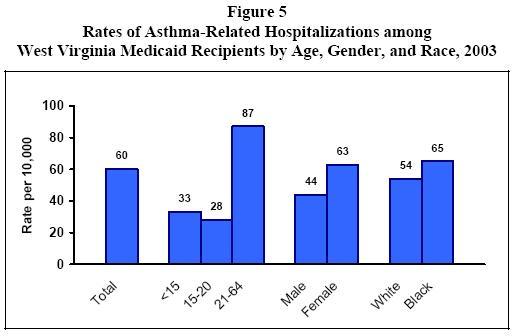
Note: Based on claims with a primary or secondary diagnosis of asthma.
See Appendix Table A4 for more detail.
Table 2.
Medicaid Reimbursements for Asthma-Related Medical Services Visits, 2003
| Medical Services | Number of Visits |
Total Amount Reimbursed |
Average Amount Reimbursed per Visit |
|---|---|---|---|
| Office/Clinic Visits | 39,185 | $3,837,147 | $98 |
| Emergency Room Visits | 6,517 | $1,270,555 | $195 |
| Hospitalizations | 2,189 | $8,829,409 | $4,034 |
| TOTAL | 47,891 | $13,937,111 | ---- |
| PRESCRIPTION MEDICATION USE & COSTS |
|---|
In 2003, there were 16,978 West Virginia Medicaid recipients who had a medical service claim with a primary or secondary diagnosis of asthma who also had at least one prescription claim for an asthma-related medication. These recipients had a total of 137,420 prescription claims for asthma-related medications – an average of 8.1 claims per recipient with asthma (defined as having had an asthma-related medical service claim and an asthma-related prescription claim).
There are two main types of asthma medications: 1) quick-relief medications, which are used to relieve symptoms during an asthma attack, and 2) long-term controller medications, which are used to prevent attacks from occurring. Most recipients with asthma who had filled a prescription for an asthma-related medication had received some type of quick-relief medication (see Figure 6). A higher percentage of recipients with asthma who had filled an asthma-related prescription had received leukotriene modifiers (39.4%) than other types of controller medications.
Medicaid reimbursed more than $7 million for asthma-related medications for recipients who had a medical service visit for asthma. The average amount reimbursed per claim was approximately $51 and the average amount reimbursed per asthma recipient was $414. Medicaid reimbursed more dollars for leukotriene modifiers than any other asthma-related class of medication ($2.7 million, see Figure 7).
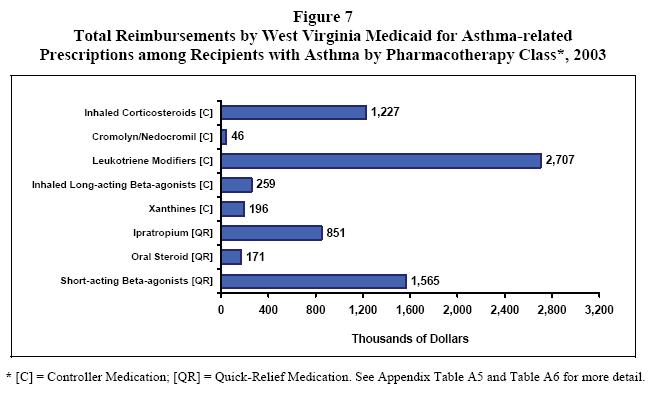
Note: Based on enrollees with at least one medical service claim with a primary or secondary
diagnosis of asthma and at least one prescription claim for an asthma-related medication
See Appendix Table A5 and Table A6 for more detail.
| APPENDIX |
|---|
METHODOLOGY
Only fee-for-service paid claims data were used in this analysis. Claims data are administrative data used for billing purposes. They provide information on all medical services and prescriptions billed to Medicaid for reimbursement. Disease conditions are identified by analyzing medical services diagnosis codes and prescription claims. Medicaid recipients were identified as having asthma if they had at least one medical service claim (office/clinic, ER, or hospital) with a primary or secondary diagnosis of asthma (ICD-9 CM codes 493.00-493.99), or at least two prescription claims for asthma-related drugs, of which at least one was for a drug other than an oral steroid. Oral steroids are used to treat many conditions other than asthma. Therefore, if a recipient had a claim for an oral steroid, he/she must also have had an asthma-related prescription claim for a medication in another pharmacotherapy class to be classified as having asthma.
The definition used to identify enrollees with asthma is based on modified criteria of the National Committee for Quality Assurance (NCQA). It is important to note that this methodology may overestimate the prevalence of asthma, asthma-related medical service and prescription use, and asthma-related costs to Medicaid. Specifically, medical service claims with only a secondary diagnosis of asthma are included in the rates presented in this brief, although the primary reason for obtaining treatment may be unrelated to asthma. In addition, asthma-related prescriptions are used to treat other respiratory conditions, such as emphysema and bronchitis. Diagnoses are not identified in prescription claims; therefore, it is unknown for what specific condition enrollees are being prescribed asthma-related mediations.
Each person identified with asthma was only counted once when estimating a prevalence rate, and an event (such as hospitalization) was only counted once in estimating utilization. The denominator for all rates was the number of recipients of West Virginia Medicaid during fiscal year 2003. Data were de-identified in compliance with HIPAA regulations. This study underwent review and approval by the West Virginia University Institutional Review Board. An analysis of 2002 Medicaid claims data was completed in 2004. The results of the 2002 analysis are summarized in Health Statistics Center Brief No. 12. Health Statistics Center briefs can be accessed online at:
http://www.wvdhhr.org/bph/oehp/hsc/vr/publicat.htm.
Table A1.
Prevalence rates of asthma in the West Virginia Medicaid population and total Medicaid reimbursements for asthma-related services – By demographic category, 2003
| Demographic variables |
Number of recipients with asthmaa (N) |
Prevalence rate per 1,000 Medicaid recipientsb,c |
Total amount reimbursedd ($) |
Average amount reimbursed per recipiente ($) |
|---|---|---|---|---|
| Age (years) | ||||
| 0-14 | 16,488 | 102 | $7,971,793 | $483 |
| 15-20 | 4,673 | 111 | $1,887,641 | $404 |
| 21-64 | 19,481 | 151 | $14,424,466 | $740 |
| 65 & over | 6,859 | --- | $4,686,522 | $683 |
| Unknown | 3,540 | --- | $1,576,487 | $445 |
| Gender | ||||
| Male | 19,610 | 126 | $11,042,321 | $563 |
| Female | 27,447 | 130 | $17,627,733 | $642 |
| Unknown | 3,984 | --- | $1,876,856 | $471 |
| Race | ||||
| White | 44,537 | 130 | $26,990,113 | $606 |
| Black | 1,926 | 101 | $1,252,917 | $651 |
| Other | 490 | --- | $353,979 | $722 |
| Unknown | 4,088 | --- | $1,949,899 | $477 |
| Total | 51,041 | 139 | $30,546,910 | $598 |
a. Total number of recipients of West Virginia Medicaid who had at least one medical service claim with a primary or secondary diagnosis of asthma or at least two prescription claims for an asthma-related medication (at least one of which was for a drug other than an oral steroid).
b. Rates based on the number of recipients of West Virginia Medicaid in fiscal year 2003 in each demographic category (Total N = 366,987).
c. Rates reported for groups classified as “other” are not reliable. Rates for recipients aged 65 and older are not reliable due to possible misclassification of asthma with other respiratory diseases and due to the impact of Medicare penetration in this age group.
d. Total = (Amount reimbursed by West Virginia Medicaid for recipients who had a medical service with a primary or secondary diagnosis of asthma, including all asthma-related prescription claims for these recipients) + (Amount reimbursed for recipients who did not have medical services for asthma, but who had at least two prescription claims for an asthma-related medication, at least one of which was for a drug other than an oral steroid).
e. Average amount reimbursed by West Virginia Medicaid for asthma-related medical services and prescription drugs per recipient identified with asthma in that demographic category.
Table A2.
Asthma-related office/clinic services among recipients of West Virginia Medicaid and reimbursements by Medicaid for the same – By demographic category, 2003
| Demographic variables |
Number of office/clinic visitsa (N) |
Rate of office/clinic visits per 1,000 recipientsb,c |
Total amount reimbursed d ($) |
Average amount reimbursed per visite ($) |
|---|---|---|---|---|
| Age (years) | ||||
| 0-14 | 11,195 | 69 | $1,370,299 | $122 |
| 15-20 | 3,157 | 75 | $352,085 | $112 |
| 21-64 | 19,065 | 148 | $1,710,864 | $90 |
| 65 & over | 3,780 | --- | $184,243 | $49 |
| Unknown | 1,988 | --- | $219,657 | $110 |
| Gender | ||||
| Male | 13,023 | 84 | $1,355,464 | $104 |
| Female | 23,516 | 111 | $2,225,198 | $95 |
| Unknown | 2,646 | --- | $256,485 | $97 |
| Race | ||||
| White | 34,823 | 101 | $3,379,502 | $97 |
| Black | 1,578 | 83 | $172,333 | $109 |
| Other | 376 | --- | $28,939 | $77 |
| Unknown | 2,408 | --- | $256,373 | $106 |
| Total | 39,185 | 107 | $3,837,147 | $98 |
a. Total number of office/clinic visits with a primary or secondary diagnosis of asthma among recipients of West Virginia Medicaid.
b. Rates based on the number of office/clinic visits with a primary or secondary diagnosis of asthma divided by the number of recipients of West Virginia Medicaid in fiscal year 2003 in each demographic category (Total N = 366,987).
c. Rates reported for groups classified as “other” are not reliable. Rates for recipients aged 65 and older are not reliable due to possible misclassification of asthma with other respiratory diseases and due to the impact of Medicare penetration in this age group.
d. Total amount reimbursed by West Virginia Medicaid for office/clinic visits with a primary or secondary diagnosis of asthma.
e. Average amount reimbursed by West Virginia Medicaid per office/clinic visit with a primary or secondary diagnosis of asthma.
Table A3.
Asthma-related ER services among recipients of West Virginia Medicaid and reimbursements by Medicaid for the same
– By demographic category, 2003
| Demographic variables |
Number of ER visitsa (N) | Rate of ER visits per 10,000 recipientsb,c |
Total amount reimbursedd ($) |
Average amount reimbursed per visite ($) |
|---|---|---|---|---|
| Age (years) | ||||
| 0-14 | 2,200 | 136 | $354,598 | $161 |
| 15-20 | 727 | 173 | $120,826 | $166 |
| 21-64 | 2,952 | 229 | $657,910 | $223 |
| 65 & over | 247 | --- | $60,527 | $245 |
| Unknown | 391 | --- | $76,694 | $196 |
| Gender | ||||
| Male | 2,395 | 154 | $432,207 | $180 |
| Female | 3,659 | 173 | $744,694 | $204 |
| Unknown | 463 | --- | $93,654 | $202 |
| Race | ||||
| White | 5,509 | 161 | $1,075,325 | $195 |
| Black | 457 | 240 | $85,739 | $188 |
| Other | 75 | --- | $16,230 | $216 |
| Unknown | 476 | --- | $93,261 | $196 |
| Total | 6,517 | 178 | $1,270,555 | $195 |
a. Total number of ER visits with a primary or secondary diagnosis of asthma among recipients of West Virginia Medicaid.
b. Rates based on the number of ER visits with a primary or secondary diagnosis of asthma divided by the number of recipients of West Virginia Medicaid in fiscal year 2003 in each demographic category (Total N = 366,987).
c. Rates reported for groups classified as “other” are not reliable. Rates for recipients aged 65 and older are not reliable due to possible misclassification of asthma with other respiratory diseases and due to the impact of Medicare penetration in this age group.
d. Total amount reimbursed by West Virginia Medicaid for ER visits with a primary or secondary diagnosis of asthma.
e. Average amount reimbursed by West Virginia Medicaid per ER visit with a primary or secondary diagnosis of asthma.
Table A4.
Asthma-related inpatient services among recipients of West Virginia Medicaid and reimbursements by Medicaid for the same
– By demographic category, 2003
| Demographic variables |
Number of hospital visitsa (N) |
Rate of hospital visits per 10,000 recipientsb,c |
Total amount reimbursedd ($) |
Average amount reimbursed per visite ($) |
Average length of stay per visitf (days) |
|---|---|---|---|---|---|
| Age (years) | |||||
| 0-14 | 529 | 33 | $2,083,137 | $3,938 | 1.6 |
| 15-20 | 118 | 28 | $422,811 | $3,583 | 2.5 |
| 21-64 | 1,122 | 87 | $4,510,395 | $4,020 | 3.0 |
| 65 & over | 261 | --- | $1,133,234 | $4,342 | 4.0 |
| Unknown | 159 | --- | $679,832 | $4,276 | 2.5 |
| Gender | |||||
| Male | 684 | 44 | $2,782,040 | $4,067 | 2.2 |
| Female | 1,323 | 63 | $5,254,781 | $3,972 | 3.0 |
| Unknown | 182 | --- | $792,588 | $4,355 | 3.3 |
| Race | |||||
| White | 1,851 | 54 | $7,383,769 | $3,989 | 2.7 |
| Black | 123 | 65 | $520,424 | $4,231 | 2.5 |
| Other | 31 | --- | $123,930 | $3,998 | 2.8 |
| Unknown | 184 | --- | $801,285 | $4,355 | 3.7 |
| Total | 2,189 | 60 | $8,829,409 | $4,034 | 2.7 |
a. Total number of hospital admissions with a primary or secondary diagnosis of asthma among recipients of West Virginia Medicaid.
b. Rates based on the number of hospital admissions with a primary or secondary diagnosis of asthma divided by the number of recipients of West Virginia Medicaid in fiscal year 2003 in each demographic category (Total N = 366,987).
c. Rates reported for groups classified as “other” are not reliable. Rates for recipients aged 65 and older are not reliable due to possible misclassification of asthma with other respiratory diseases and due to the impact of Medicare penetration in this age group.
d. Total amount reimbursed by West Virginia Medicaid for hospital admissions with a primary or secondary diagnosis of asthma.
e. Average amount reimbursed by West Virginia Medicaid per hospital admission with a primary or secondary diagnosis of asthma.
f. Average length of stay per hospital visit with a primary or secondary diagnosis of asthma.
Table A5.
Asthma-related prescription utilization among recipients of West Virginia Medicaid with
asthma and reimbursements by Medicaid for the same
– By demographic category, 2003
| Demographic variables |
Number of recipients with asthma (N1)a |
Number of prescription claims (N2)b |
Average number of claims per recipientc |
Total amount reimbursedd ($) |
Average amount reimbursed per recipiente ($) |
|---|---|---|---|---|---|
| Age (years) | |||||
| 0-14 | 6,262 | 36,984 | 5.9 | $2,170,731 | $347 |
| 15-20 | 1,819 | 10,176 | 5.6 | $476,388 | $262 |
| 21-64 | 6,831 | 70,735 | 10.4 | $3,455,362 | $506 |
| 65 & over | 1,026 | 14,610 | 14.2 | $702,863 | $685 |
| Unknown | 1,040 | 4,915 | 4.7 | $216,173 | $208 |
| Gender | |||||
| Male | 6,423 | 47,735 | 7.4 | $2,544,527 | $396 |
| Female | 9,375 | 83,515 | 8.9 | $4,201,893 | $448 |
| Unknown | 1,180 | 6,170 | 5.2 | $275,098 | $233 |
| Race | |||||
| White | 14,859 | 124,581 | 8.4 | $6,418,114 | $432 |
| Black | 766 | 4,865 | 6.4 | $236,744 | $309 |
| Other | 135 | 1,427 | 10.6 | $66,026 | $489 |
| Unknown | 1,218 | 6,547 | 5.4 | $300,633 | $247 |
| Total | 16,978 | 137,420 | 8.1 | $7,021,517 | $414 |
a. Number of recipients of West Virginia Medicaid who had at least one medical service claim with a primary or secondary diagnosis of asthma and at least one prescription claim for an asthma-related medication.
b. Number of prescription claims for asthma-related medications for each demographic category.
c. Average number of prescription claims for asthma-related medications per recipient in each demographic category.
d. Total amount reimbursed by West Virginia Medicaid for prescriptions for asthma-related medications.
e. Average amount reimbursed by West Virginia Medicaid for asthma-related medications per recipient.
Table A6.
Recipients of West Virginia Medicaid with asthma, prescription claims, and amounts reimbursed by Medicaid by pharmacotherapy class, 2003
| Pharmacotherapy Class | Number (and %) of recipients with asthmaa (N1) |
Number (and %) of prescription claimsb (N2) |
Total amount reimbursedc ($) |
Average amount per claimd ($) |
||
|---|---|---|---|---|---|---|
| Spacer devices | --- | --- | --- | --- | --- | --- |
| Short-acting beta- agonists (all dosage forms) | 14,299 | 84.2% | 51,261 | 37.3% | $1,565,107 | $31 |
| Oral corticosteroids | 8,159 | 48.1% | 16,819 | 12.2% | $171,267 | $10 |
| Inhaled corticosteroids | 4,022 | 23.7% | 11,926 | 8.7% | $1,227,494 | $103 |
| Ipratropium | 2,699 | 15.9% | 12,044 | 8.8% | $850,712 | $71 |
| Methylxanthines | 1,143 | 6.7% | 7,933 | 5.8% | $194,806 | $25 |
| Inhaled Long-acting beta-agonists | 933 | 5.5% | 3,219 | 2.3% | $258,816 | $80 |
| Leukotriene modifiers | 6,697 | 39.4% | 33,481 | 24.4% | $2,706,647 | $81 |
| Cromolyn/Nedocromil | 252 | 1.5% | 737 | 0.5% | $46,670 | $63 |
| Total | 16,978 | 100%e | 137,420 | 100%e | $7,021,517 | $51 |
a. Based on recipients with at least one medical service claim with a primary or secondary diagnosis of asthma and at least one prescription claim for an asthma-related medication.
b. Number of prescription claims in each pharmacotherapeutic category.
c. Total amount reimbursed by West Virginia Medicaid for prescriptions in each pharmacotherapeutic category.
d. Average amount reimbursed by West Virginia Medicaid per claim in each pharmacotherapeutic category.
e. Column sums to more than 100% due to recipients who had claims in more than one pharmacotherapeutic category.
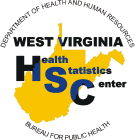
|
West Virginia Health Statistics Center |
|
350 Capitol Street, Room 165 Charleston, WV 25301-3701 Phone: (304) 558-9100 Fax: (304) 558-1787 Web: http://www.wvdhhr.org/bph/oehp/hsc/default.htm |
|
| The Health Statistics Center (HSC) maintains West Virginia vital records and conducts the Behavioral Risk Factor Survey. The HSC can do customized reports and data analysis for grants, formal research, agency use, or specific community health planning activities. For additional information call the HSC and ask for a Statistical Services staff member. Visit the HSC website for electronic access to HSC reports and statistical briefs. This publication was supported by the Cooperative Agreement number U59/CCU324180-03 from the Centers for Disease Control and Prevention. Its contents are solely the responsibility of the authors and do not necessarily represent the official views of the Centers for Disease Control and Prevention. It was produced in collaboration with the West Virginia Asthma Coalition. |
Last updated September 24, 2007.
If you have any questions, contact the Health Statistics Center at:
Phone: 304-558-9100 or
Email:dhhrvitalreg@wv.gov